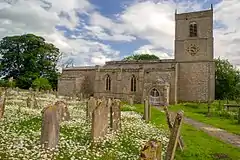Redundant church
A redundant church is a church building that is no longer used for Christian worship. The term most frequently refers to former Anglican churches in the United Kingdom,[1] but may also be used for disused churches in other countries.

Reasons for redundancy include population movements, changing social patterns, merging of parishes, decline in church attendance (especially in the Global North) or other factors. Historically, redundant churches were often demolished or left to ruin. Today, many redundant churches are repurposed e.g. as community centres, museums, or homes; demolition occurs only if no alternative can be found.
Anglican buildings
Although some church buildings fall into disuse around the world, in England, the term "redundancy" was particularly used by the Church of England which had a Redundant Churches Division. In 2008, the Church changed the terminology surrounding church closure and as such "redundancy" is now known as "closure for regular public worship". The Redundant Churches Division became the Closed Churches Division.[2]

There are a number of reasons for a church building being declared redundant, although it is primarily due to a reduction in the number of regular Sunday worshippers, which fell since the late 1980s to about 1.7m in 2008.[3][4] Other reasons include the amalgamation of parishes, or a preference for another building where two churches exist in close proximity, for example at Swaffham Prior, Cambridgeshire. Population shift is another factor. For example, many redundant churches were formerly maintained in parishes situated in deserted or shrunken medieval villages (such as Wharram Percy in Yorkshire). The square mile City of London has only a few thousand permanent residents, far smaller than its historic population because most workers now commute from outside its boundaries, so there are many redundant churches within the City.
Approximately 30 Church of England churches are declared closed for regular public worship each year.[5] The buildings are only demolished as a last resort. Some active use is made of about half of the closed churches. Between 1969 and 2010, a full 1795 closures were achieved, equalling roughly 11% of the stock, with about a third Listed as Grade I or II. (Of these closures, only 514 were made since 1990.) Only 20% of closed churches were demolished and 75% of those were unlisted.[6]
The aim of the closure process is to find new uses for them. Responsibility for doing this rests with the diocese. Some closed churches remain consecrated in occasional use by the Church of England. Some are purchased by other denominations or faiths for regular use. Several charitable trusts have been set up to preserve churches of particular architectural merit, such as the Churches Conservation Trust in England or the Friends of Friendless Churches in Wales (although the latter also maintains a number of churches in England). Similarly, Historic Churches Scotland cares for several former Church of Scotland church buildings.
Re-use
Closed churches can have a variety of uses. Depending on the listed status of a building, many can be converted for other uses. Several former churches are used as community or education centres, for example All Saints' Church, Bristol or All Saints Church, Harthill. Likewise, Holy Trinity Church, Chester now serving as the town's Guildhall or St Michael's Church, Chester as a heritage centre. St Peter's Church, Offord D'Arcy managed by the Churches Conservation Trust is used to host festivals, including a film festival.
Others are used in more unusual ways; Old St Ann's Church, Warrington is an indoor climbing centre (one of several churches used in this way), other former churches may be art galleries, coffee shops and even pubs and clubs (e.g. High Pavement Chapel in Nottingham). Many are converted into residential properties.[4]
However, in some cases, such as the grade I listed St Ninian's, Brougham, a Churches Conservation Trust church, the remote location means that it cannot be used for an alternative purpose and is rarely used for worship.
Methodist buildings
The popularity of Methodism, and other non-conformist churches in the 19th century has led to many chapel buildings which cannot be sustained; at their height, various Methodist factions ran about 14,000 chapels in the United Kingdom. Today, the United Methodists own just over 6,000 chapels and dispose of roughly 100 each year.[4] Particularly significant chapels may be taken into the care of the Historic Chapels Trust.
References
- Disposal of redundant churches and other places of worship, GOV.UK, accessed 20 June 2018
- Closed Churches, Church of England, accessed 20 June 2018
- Church of England: "around 1.7 million people continue to attend Church of England services each month", 22 January 2010
- "Redundant churches: Pints in the pews", The Economist, 28 March 2002
- Closed Churches Division
- http://www.theheritagealliance.org.uk/hrba/wp-content/uploads/2015/01/churches-and-closure-in-cofe-mar-2010.pdf, p=2